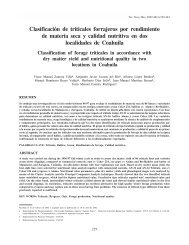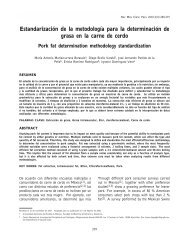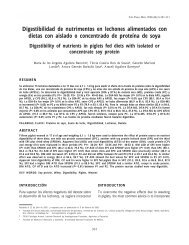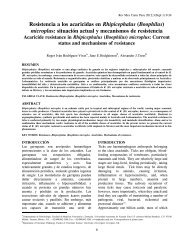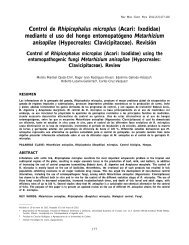Evaluación de tres niveles de pigmento de flor de cempasúchil ...
Evaluación de tres niveles de pigmento de flor de cempasúchil ...
Evaluación de tres niveles de pigmento de flor de cempasúchil ...
You also want an ePaper? Increase the reach of your titles
YUMPU automatically turns print PDFs into web optimized ePapers that Google loves.
En cuanto al <strong>de</strong>pósito <strong>de</strong> <strong>pigmento</strong>s rojos en la<br />
piel, no existió diferencia entre tratamientos; esto<br />
se <strong>de</strong>be a que las xantofilas <strong>de</strong> <strong>flor</strong> <strong>de</strong> <strong>cempasúchil</strong><br />
sólo aportan xantofilas amarillas (5) .<br />
Se ha mencionado que con la inclusión <strong>de</strong> 60 ppm<br />
<strong>de</strong> xantofilas en dietas para pollos <strong>de</strong> engorda se<br />
obtiene una pigmentación aceptable en 56 días <strong>de</strong><br />
edad <strong>de</strong>l pollo (1); en el presente experimento con<br />
esta cantidad <strong>de</strong> <strong>pigmento</strong> en la dieta, a los 47 días<br />
<strong>de</strong> edad se obtuvo un nivel <strong>de</strong> amarillamiento <strong>de</strong><br />
39.1, siendo que el mínimo recomendado es <strong>de</strong><br />
41 (9) , y no cumple las exigencias <strong>de</strong> pigmentación<br />
en el mercado, por lo que se requeriría <strong>de</strong> más<br />
tiempo en el consumo <strong>de</strong> <strong>pigmento</strong> para llegar a un<br />
<strong>de</strong>pósito mayor <strong>de</strong>l aditivo en la piel <strong>de</strong> los pollos.<br />
Al adicionar 80 ppm se mejoró la pigmentación<br />
5.5 puntos respecto a la dieta con 60 ppm, datos<br />
que indican que al aumentar 20 ppm <strong>de</strong> <strong>pigmento</strong><br />
en la dieta se mejora la pigmentación <strong>de</strong> la piel al<br />
mismo nivel que si la alimentación se proporcionara<br />
en 56 días con un nivel <strong>de</strong> 60 ppm, tal como lo<br />
señalan Cuca et al. (1) .<br />
En evaluaciones por medio <strong>de</strong> colorimetría <strong>de</strong><br />
reflectancia se marca un valor mínimo <strong>de</strong> 41 en la<br />
escala <strong>de</strong> amarillamiento, y <strong>de</strong> 2 en enrojecimiento,<br />
para consi<strong>de</strong>rar al pollo un producto con buena<br />
pigmentación a nivel comercial (4,9) .<br />
Los resultados <strong>de</strong> luminosidad mostraron un menor<br />
valor numérico con 80 ppm; esto se <strong>de</strong>be a que<br />
consumieron mayor cantidad <strong>de</strong> xantofilas, por lo<br />
que probablemente se presentó mayor <strong>de</strong>posición<br />
<strong>de</strong> luteína, ya que un color más intenso refleja<br />
menos luz; lo que concuerda con otra<br />
investigación (14) , don<strong>de</strong> se evaluó el po<strong>de</strong>r<br />
pigmentante <strong>de</strong> la luteína y la capsaxantina en pollos<br />
<strong>de</strong> engorda.<br />
Se concluye que el uso <strong>de</strong> xantofilas saponificadas<br />
<strong>de</strong> <strong>flor</strong> <strong>de</strong> <strong>cempasúchil</strong> no causó ningún efecto<br />
sobre los indicadores productivos en el pollo <strong>de</strong><br />
engorda, y que la pigmentación amarilla <strong>de</strong> la piel<br />
a los 47 días <strong>de</strong> edad fue mayor en el tratamiento<br />
con 80 ppm en la dieta, resultando ser el nivel<br />
a<strong>de</strong>cuado <strong>de</strong> xantofilas saponificadas <strong>de</strong> <strong>flor</strong> <strong>de</strong><br />
<strong>cempasúchil</strong>, para obtener una buena pigmentación<br />
que exige el mercado <strong>de</strong>l valle <strong>de</strong> México.<br />
Miguel Martínez Peña, et al. / Téc Pecu Méx 2004;42(1):105-111<br />
110<br />
skin yellowing in the productive cycle was higher<br />
in those treatments which received natural yellow<br />
pigments at high levels (85 ppm). Addition of<br />
xanthophylls at increasing levels (60, 70, 80 and<br />
90 ppm) were evaluated in broilers diets from 4 to<br />
7 wk of age, and the 80 ppm level was found as<br />
a<strong>de</strong>quate (13) .<br />
No differences were found between treatments for<br />
red pigment <strong>de</strong>position in skin, most probably<br />
because Aztec marigold flowers provi<strong>de</strong> only yellow<br />
xanthophylls (5) .<br />
It has been mentioned that 60 ppm xanthophylls<br />
when ad<strong>de</strong>d to broilers diets produce an a<strong>de</strong>quate<br />
yellow pigmentation at 56 d of age (1). In the present<br />
study at that rate, at 47 d of age a 39.1 yellowness<br />
level was obtained, being 41 the acceptable<br />
recommen<strong>de</strong>d minimum (9) , not meeting market<br />
requirements, and therefore needing if this were<br />
the case, a longer breeding period. When 80 ppm<br />
were ad<strong>de</strong>d, 5.5 points more than with the 60 ppm<br />
diet were obtained for the same time span, data<br />
which indicate that when an extra 20 ppm are<br />
ad<strong>de</strong>d to the last diet, skin pigmentation acquires<br />
the same level that is attained in 56 d, as mentioned<br />
by Cuca et al. (1) .<br />
In evaluations carried out with reflectance<br />
colorimetry a minimum value of 41 in the yellow<br />
scale and of 2 in the red scale are fixed to consi<strong>de</strong>r<br />
a broiler with good commercial pigmentation (4,9) .<br />
Results on lightness showed a lower numeric value<br />
with the 80 ppm diet. This could be owing to a<br />
higher xanthophyll intake, which in turn caused a<br />
greater lutein <strong>de</strong>position. Intense colors reflect less<br />
light, data which concurs with the findings of other<br />
researchers (14) , who evaluated the pigmentation<br />
capacity of lutein and capsaxanthin in broilers.<br />
It can be conclu<strong>de</strong>d that Aztec marigold flowers<br />
saponified xanthophylls have no effects on broilers<br />
productive parameters and also that yellow skin<br />
pigmentation at 47 days of age was higher in diets<br />
ad<strong>de</strong>d with 80 ppm xanthophylls, being this level<br />
a<strong>de</strong>quate to obtain the skin pigmentation required<br />
by the mexican consumer.



